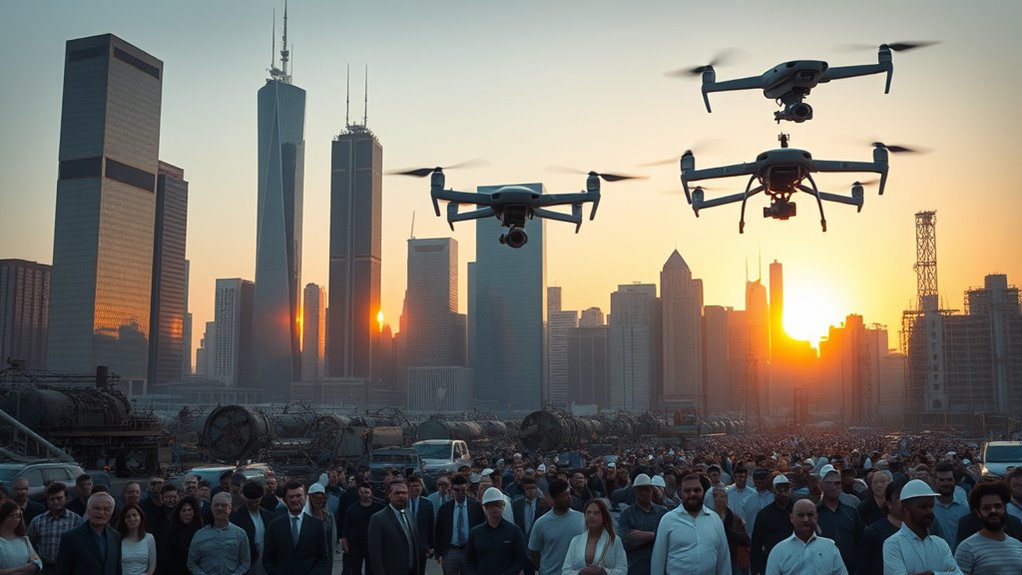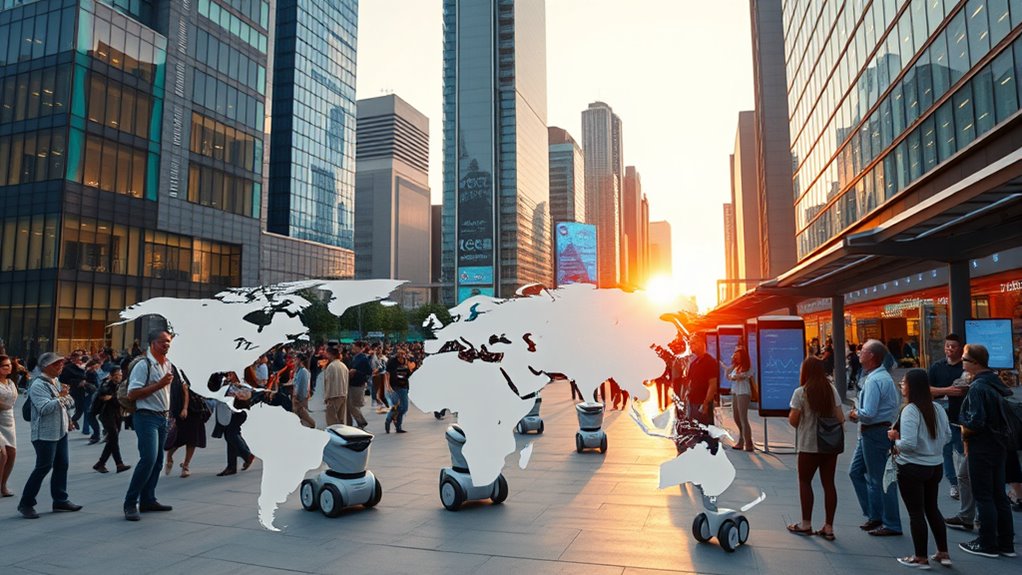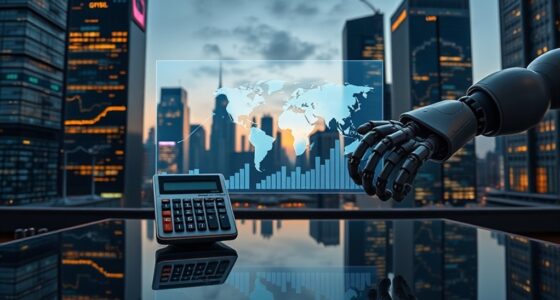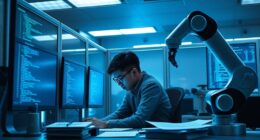As robots and AI take over work, traditional taxes on income from labor decline, leaving governments with less revenue to fund society. You’ll need new ways to pay for public services, like taxing automation profits, wealth, or data. This shift also raises questions about inequality and how to support displaced workers. If you want to understand how policies can adapt to guarantee everyone benefits in this new economy, keep exploring this essential topic.
Key Takeaways
- Automation reduces traditional tax revenues from wages, requiring new funding sources like taxes on AI profits or robot usage.
- Implementing a robot tax or capital gains tax on automation assets can help fund public services.
- Shifting tax focus from labor to capital and automation-related income addresses revenue shortfalls.
- International cooperation and innovative policies are needed to create fair and effective taxation systems in the automation era.
- Redistribution mechanisms, such as wealth taxes, can ensure social equity as automation concentrates wealth.
Economic Shifts and Societal Changes in the Automation Era

The automation era is fundamentally transforming economies and societies, reshaping the way work is done and how wealth is distributed. As automation replaces millions of manufacturing jobs worldwide, you’ll notice shifts in employment, especially among routine and middle-skill roles. By the mid-2030s, up to a third of all jobs could be at risk, mostly affecting lower and middle-income workers. Wage polarization worsens, with less-skilled workers facing stagnant or declining wages since 1980, while high-skilled workers benefit. Productivity soars—US auto manufacturing, for example, saw a 128% increase from 1993 to 2014—yet wage gains lag behind. Since 2000, 1.7 million jobs have been lost globally to automation, with the US alone losing 260,000 manufacturing jobs to robots—these changes deepen economic inequality, challenge social safety nets, and demand a reevaluation of how societies manage wealth, work, and opportunity. Additionally, the shift toward automation calls for innovative approaches to wealth redistribution to ensure broader societal well-being.
Rethinking Traditional Tax Systems in a Robotic World

As automation transforms how value is created, your traditional tax systems need to adapt to shifting revenue sources. You’ll have to contemplate new policy models that address declining labor taxes and increased capital income. Rethinking these systems now is essential to guarantee sustainable funding and fairness in a robotic world. Automation’s impact on tax revenues highlights the urgency of reforming fiscal policies to ensure long-term economic stability. Additionally, understanding the role of color accuracy in projectors can inform how visual data and digital representations are integrated into future economic models and policy discussions. Recognizing the importance of Gold IRA investments can also offer insights into alternative asset classes that might support economic resilience amidst automation-driven change. Implementing progressive taxation could be one way to address income disparities caused by automation. Furthermore, the rise in AI-driven security systems could influence new tax incentives for tech innovation and cybersecurity investments. Regular assessments of software quality assurance practices can help in developing effective strategies for managing technological advancements and their fiscal implications.
Shifting Revenue Sources
In a world increasingly driven by automation, traditional tax systems struggle to keep pace with rapidly evolving economic realities. You’ll notice that taxes on labor are high, often exceeding 28.5%, while capital enjoys low rates around 5%, encouraging automation. Favorable depreciation policies further reduce taxes on capital investments, making automation more attractive. As automation grows, revenue sources need to shift. Potential streams include taxes on robots and AI, which could generate funds to support displaced workers and fund social services. Other options like capital gains taxes and value-added taxes (VAT) could also play a role in stabilizing revenue. These shifts aim to balance economic incentives, curb excessive automation, and ensure society’s financial sustainability as technology transforms work and productivity.
New Tax Policy Models
Traditional tax systems rely heavily on taxing labor income, but automation erodes this base and reduces government revenues. To address this, new models propose taxing robots or automation directly, generating funds to support displaced workers through social programs and retraining. These policies can incentivize firms to consider human employment strategically rather than fully automating. Some ideas include taxing productivity gains from AI or robotics, adjusting value-added or corporate taxes, or taxing inputs like data and energy. These approaches aim to redistribute automation’s benefits, fund social safety nets, and promote inclusive growth. Additionally, implementing Glycolic Acid Benefits for Skin in certain industries may influence the economic landscape by affecting consumer spending on skincare. Moreover, accurately measuring robot use remains a significant challenge, complicating the enforcement of such taxes. Developing reliable methods for tracking robot deployment is essential for effective taxation and oversight. Furthermore, advancements in automation tracking technologies can facilitate better measurement and compliance. However, implementing such taxes faces challenges, including measuring robot use accurately, preventing tax avoidance, and balancing innovation incentives with revenue needs. Evolving these models is vital for sustainable, fair taxation in an increasingly automated economy.
Addressing Income Inequality and Financing Public Services

The rise of AI-driven automation challenges existing ways of funding public services by shrinking traditional tax bases, especially income taxes from wages. As automation replaces high-wage jobs, your tax revenue from labor diminishes, forcing governments to seek new sources. To address this, consider these strategies:
- Tax capital gains and AI-generated profits to capture wealth accumulated by capital owners.
- Implement wealth taxes on AI-driven assets to redistribute automation gains.
- Rethink payroll and income taxes to include automation’s economic impacts, ensuring fair contributions. Research indicates AI could reduce wage inequality by displacing high-income workers, which further affects tax revenues from labor. Additionally, exploring tax policy adaptations can help governments better respond to the evolving economic landscape caused by automation. Recognizing the importance of income redistribution mechanisms can further support social equity during this transition.
These measures aim to reduce wealth inequality, prevent budget shortfalls, and sustain public services amid widespread automation. By adjusting tax policies, you can help balance economic disparities and support societal stability in the automation age.
Emerging Policies and Innovative Approaches to Funding Society

As automation transforms economies worldwide, policymakers are exploring innovative approaches to fund society’s needs. They’re considering tax reforms like adjusting VAT rates to better target digital goods and services, and implementing carbon taxes to promote sustainability while generating revenue. Some countries are exploring the idea of a robot tax to directly fund social programs, though it remains speculative. International cooperation is critical, with efforts to develop multilateral frameworks ensuring fair taxation of multinational corporations and standardizing cross-border tax rules. Data-driven strategies, such as using analytics for tax collection, are gaining traction. Progressive wealth taxes are also discussed to address growing disparities caused by automation. These emerging policies aim to create a sustainable, fair funding system in an increasingly automated world. Failure to pass effective tax legislation in 2025 could hinder the implementation of these innovative solutions and impact the future of funding society. Recognizing the importance of understanding cost variances, such as production and overhead variances, can aid policymakers in designing more effective fiscal strategies that reflect economic realities, including the impact of tax policy adjustments on different sectors. Additionally, considering the implementation of comprehensive tax reforms can help address gaps in revenue streams caused by automation and technological advancements.
Preparing the Workforce and Supporting Transition Strategies

With automation transforming industries worldwide, preparing the workforce for this shift becomes a critical priority. You need to focus on three key strategies:
- Upskilling and Reskilling: Workers must acquire new skills to switch occupations and stay relevant, especially as many face displacement. Emphasizing career adaptability helps individuals remain competitive in changing markets.
- Education Reform: Transform education systems to teach automation-related skills early, making future generations more adaptable.
- Supportive Policies: Implement vocational training, active labor market programs, and social safety nets to help workers transition smoothly.
These measures reduce unemployment risks and foster a resilient workforce. Countries that invest in these areas, like through robust vocational programs, will manage automation’s impact more effectively. Preparing now makes sure you’re not left behind as industries evolve. Investing in workforce development is essential to ensure long-term economic stability in an era of rapid technological change.
Global Collaboration and the Future of Economic Resilience

Global collaboration plays a pivotal role in shaping the future of economic resilience amid ongoing challenges. By engaging in international forums like the G20 and OECD, you can help foster policy coordination that stabilizes markets and promotes sustainable growth. Regional integrations, such as the EU, facilitate cooperation among member states, strengthening collective resilience. Trade agreements, both bilateral and multilateral, open markets and support global trade recovery, which is essential as trade volumes increase. The IMF’s role in maintaining economic stability emphasizes the importance of shared efforts. Technological advancements, like automation, demand coordinated responses to manage job displacement and inequality. Additionally, understanding beginners guides can help policymakers implement effective strategies for economic adaptation. For instance, adopting essential oils for health and well-being can support workforce resilience by reducing stress and improving overall health, which is crucial in times of economic change. Recognizing the impact of angel numbers on societal shifts can also inspire new perspectives on economic transformation. Furthermore, the rapid pace of technological change necessitates adaptive policies that can respond swiftly to emerging challenges. This requires ongoing international dialogue and cooperation to develop effective solutions that address complex global issues. Ultimately, global collaboration ensures that economies adapt together, leveraging innovation and policy synergy to create a resilient future in an increasingly interconnected world. Effective tariff rates at levels not seen in a century underscore the need for coordinated trade policies to mitigate rising trade tensions and support global economic stability.
Frequently Asked Questions
How Will Automation Impact Small Businesses Financially?
Automation can substantially boost your small business’s finances by cutting operational costs and reducing errors. You’ll save time on routine tasks, increase productivity, and make better decisions with real-time data. This means faster growth, improved accuracy, and more time to focus on strategic goals. Overall, automation helps your business become more efficient and competitive, leading to higher profitability and success in the long run.
What Role Do International Organizations Play in Taxing Robots?
You should understand that international organizations, like the OECD, play a vital role in setting global guidelines for taxing robots. They work to create standardized policies, promote cooperation among countries, and develop legal frameworks. This helps prevent unfair competition and guarantees that robot taxes are fair and effective worldwide. By facilitating agreements and harmonizing regulations, these organizations help manage the economic and social impacts of automation on a global scale.
Can Automation-Driven Growth Reduce Overall Tax Revenue?
Automation-driven growth can initially lower your tax revenue because it reduces income from workers and shifts focus to capital earnings. However, as new industries emerge and productivity rises, your overall tax base might stabilize or grow. To guarantee steady revenue, you should consider adjusting tax policies—perhaps taxing automation or capital gains—to offset losses from decreased labor income and promote economic fairness.
How Might New Taxes Affect Innovation and Technological Progress?
You might worry that new taxes on automation could slow down innovation and technological progress. If taxes are too high, you’ll see increased development costs, discouraging investment and delaying new breakthroughs. However, when designed carefully—such as modest robot taxes—you can balance encouraging innovation with funding social needs. Properly calibrated taxes can motivate strategic tech adoption without stifling growth, ensuring ongoing progress while addressing economic and social concerns.
Who Should Be Responsible for Funding Social Safety Nets?
Imagine a society where robots handle most work, leaving humans in need. You’re responsible for funding social safety nets, which should be financed through fair taxes on corporations and automation profits. By sharing the wealth generated by technology, you guarantee support for displaced workers. You can also advocate for innovative funding sources like robot taxes, creating a safety net that keeps society stable amid rapid technological change.
Conclusion
As you navigate this new normal, remember that rethinking, reimagining, and reforming are key. By embracing innovative ideas, initiating inclusive initiatives, and inspiring international cooperation, you can help shape a sustainable society where automation benefits all. Together, you can tackle tax transformations, address inequality, and build a balanced, resilient future. Stay proactive, push for progress, and prepare to prosper in the evolving economy of automation.









